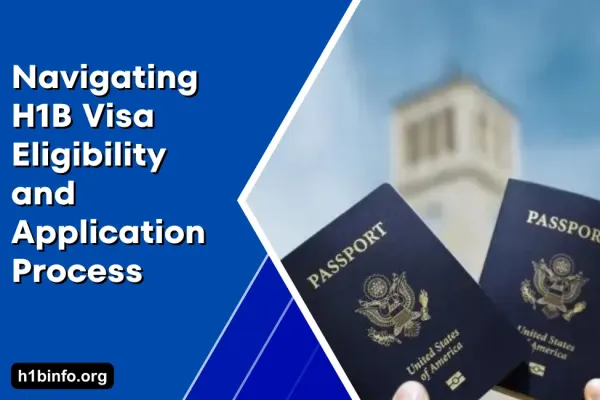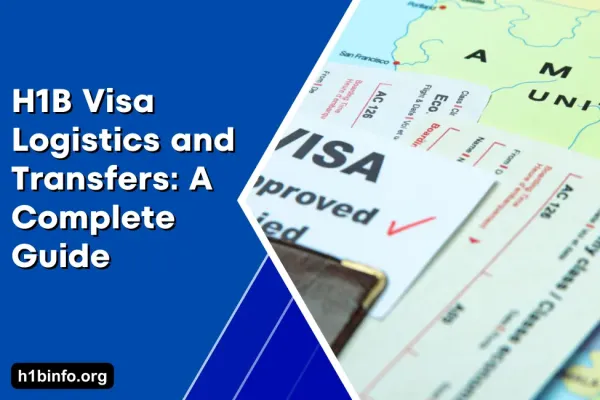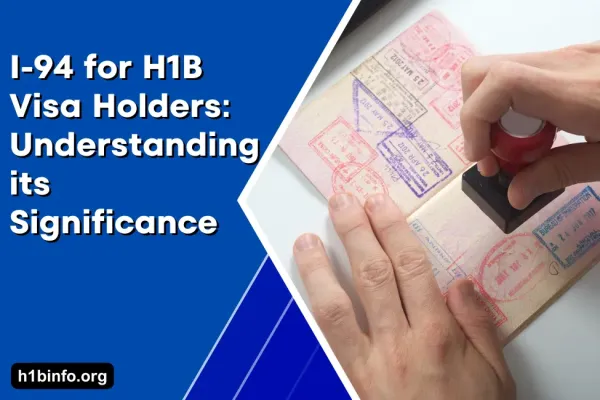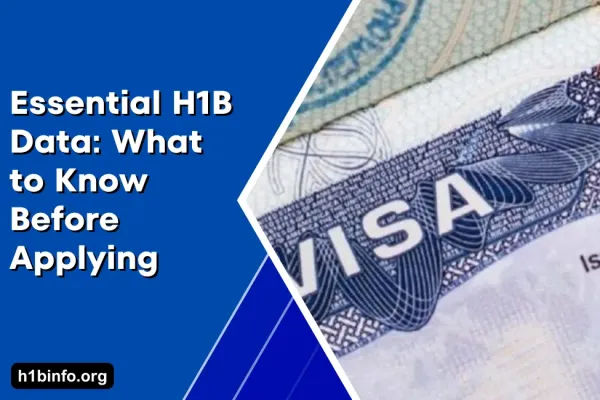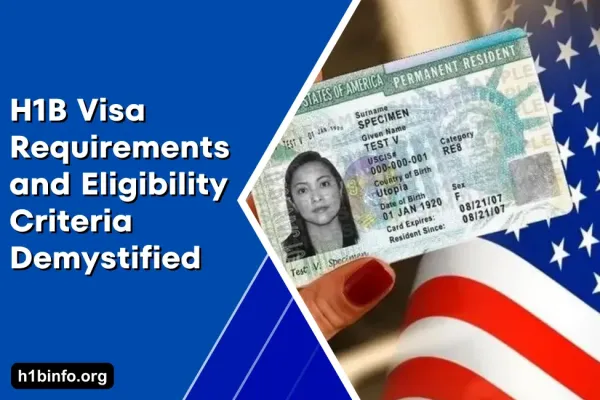Understanding the nuances of the H1B Visa may be the key to achieving your goals in an increasingly interconnected global landscape. The H-1B visa application submission process for the fiscal year 2025 will start on March 6, according to a US federal agency that announced on Tuesday.
Introduction to H1B Visa
-
What Is The H1B Visa?
The H1B Visa, a symbol of opportunity for skilled professionals worldwide, opens doors to the vibrant job market of the United States. It invites foreign talents to engage in specialized roles across diverse industries, from technology to healthcare. Beyond a mere work permit, it represents a gateway to growth, innovation, and endless possibilities.
-
Importance of the H1B Visa
Why does the H1B Visa hold such paramount significance? The enigmatic veracity lies in its role as the life force of America's reservoir of talent. Proficient immigrants, armed with their unparalleled expertise, inject a rejuvenating vigor into the U.S. labor pool, propelling innovation and augmenting economic dynamism. Nevertheless, it transcends the mere importation of skills; it embodies the essence of bridging skill disparities and propelling American industries to unprecedented zeniths. The H1B Visa empowers employers to access a global wellspring of talent, cultivating competitiveness in the global arena.
H1B Visa Eligibility
The H1B Visa, a highly sought-after pathway for skilled foreign professionals to work in the United States, involves navigating complex eligibility criteria, including educational and employment prerequisites, employer involvement, and the enigmatic quota and lottery system. This intricate process demands meticulous attention to detail and a keen understanding of its multifaceted requirements.
-
Educational Requirements
Primarily, aspiring candidates for the H1B visa program must possess an educational background that harmonizes with their target occupational role. Typically, a U.S. bachelor's degree or its equivalent serves as the conventional benchmark. Nevertheless, certain specialized vocations may mandate advanced academic credentials or specialized certifications. It presents a complex jigsaw puzzle of academic qualifications that individuals must meticulously assemble to meet the stringent eligibility criteria for the H1B visa program.
-
Employment Requirements
In the complicated domain of H1B visa eligibility, we encounter the riddle of employment prerequisites. Acquiring an H1B Visa demands the attainment of a job proposition from an American employer, introducing a multifaceted dimension to the procedure. The proposed position must not only harmonize with the aspirant's qualifications but also fall within the purview of specialized vocations, engendering a thought-provoking quandary for both prospective employees and their potential employers.
-
Employer Sponsorship
For an H1B visa, the importance of employer sponsorship emerges as an indispensable component. The sponsoring entity assumes a substantial and intricate role in this intricate process, encompassing the initiation of essential petitions and unwavering adherence to defined wage standards. The intricacy further manifests in the employer's unwavering commitment to bolster the aspirant's odyssey towards obtaining the visa, entailing multifaceted legal and financial obligations.
-
Quota and Lottery System
At last, we arrive at the allocation and raffle mechanism, arguably the most enigmatic facet of H1B eligibility. Owing to the overwhelming demand for H1B Visas, there exists a ceiling on the number of visas dispensed each fiscal year. When submissions surpass this threshold, a game of chance is introduced, infusing an element of randomness into an already convoluted procedure. Aspiring visa beneficiaries must grapple with the unpredictability of the attraction, yearning for their moment to shine amid the intricacies.
Step-by-Step Guide for an H1B Visa Application Process
-
Step #1: Identifying a Sponsor
In the approach of seeking an H-1B visa, finding a sponsoring employer is prominent. If you're presently in the United States on an F1 visa, confer with your employer regarding H-1B sponsorship. For individuals on different visa types like L1, seeking advice from an immigration attorney is advisable. Your H-1B visa can be sponsored by your current or prospective employer, provided they agree to support your application. The key is securing the commitment of sponsorship from the employer, whether new or existing.
-
Step #2: Employer Files a Labor Condition Application
Labor Condition Application (LCA) emerges as an inescapable requisite, compelling every employer harboring intentions to engage a foreign national under the H-1B visa umbrella. Submission of stated documentation is incumbent upon the declared employer, directed towards the august entity known as the U.S. Department of Labor (DOL). However, navigating the complicated corridors of LCA certification mandates adherence to a myriad of obligatory procedures of no insignificant importance.
-
Step #3: Employer Obtains a Prevailing Wage
The fundamental objective of the prevailing wage mandate resides in its role of ensuring that foreign laborers receive compensation commensurate with their domestic counterparts within the same occupational sphere and geographical locale. Verification of both the prevailing and actual wage rates falls under the purview of the State Employment Security Agency.
Should the prevailing wage surpass the remuneration offered by the prospective employer, it necessitates the initiation of a wage determination procedure. Of paramount significance is the assurance that foreign laborers do not engage in labor for less than the statutory minimum.
The prevailing wage, specific to a given geographic region, remains subject to oversight by the Foreign Labor Certification Data Center. The task of ascertaining the pertinent prevailing wage for H-1B visa petitions can be undertaken through any of the following trilateral sources:
- Attainment of a Prevailing Wage Determination from the National Prevailing Wage and Center (NPWC).
- Completion of an exhaustive survey conducted by an impartial, authoritative entity.
- Acquisition of wage intelligence from an alternative, yet reputable source.
It is, however, sagacious for employers to procure their Prevailing Wage Determinations from the most dependable of the aforementioned triumvirate, namely the NPWC, as it confers "safe harbor status" upon them.
-
Step #4: Employer Submits Form ETA-9035
After obtaining the prevailing wage, the employer will need to submit the LCA by filing Form ETA-9035 with the DOL. The application must be submitted electronically via the Foreign Labor Application Gateway (FLAG) system. The form must not be submitted more than six months from the starting date of the period of employment.
Employers who have physical disabilities or those who lack internet access may be allowed to file their ETA 9035 by mail if they send a prior request for special permission to the Office of Foreign Labor Certification (OFLC).
-
Step #5: Employer Files Form I-129
Upon the conclusion of the LCA procedure, the employer gains the prerogative to initiate the H-1B petition process by formal submission of Form I-129, more formally recognized as the "Petition for Nonimmigrant Workers."
The employer bears the onus of ensuring the incorporation of a comprehensive employment missive, delineating the precise responsibilities entailed by the position, commencement, and termination dates of employment, an elaborate position description, the remuneration package proffered, requisites for the position, contact particulars, and other pertinent details.
Moreover, as part of the supporting dossier, the foreign employee is mandated to furnish evidence of their scholastic attainments, certifications of training, documentation substantiating membership affiliations, a comprehensive curriculum vitae, and a letter of endorsement.
The culminating phase in the H-1B visa application progression entails the verification of the H-1B visa petition's status. This verification is effectuated by inputting the receipt number assigned to the petition into the official USCIS web portal. After the inclusion of your application within the USCIS records, updates on the application's status are duly annotated within their system.
-
Step #6: Complete the Application
After the approval of your I-129, you'll receive Form I-797, marking a significant step in the immigration process. If you're already in the United States, your status will automatically shift to H-1B, a coveted classification. The USCIS will update your I-94 record to reflect this change. However, you must wait for this status change before seeking employment.
To obtain an H-1B visa stamp, a crucial requirement, you need to complete the DS-160 form and schedule a visa appointment no more than 90 days before starting work in the U.S. This option is available to those with valid nonimmigrant statuses like O-1, J-1, or L-1.
10 Points to Note While Going through H1B Visa Process in 2025
- The USCIS states that the official registration window for the fiscal 2025 H-1B cap will commence on March 6 at noon Eastern and remain open until March 22. Prospective petitioners and their advocates, if any, must use a USCIS online account and pay the registration fee for each beneficiary to electronically register them for the selection process during this period.
- Companies will be able to open an account on February 28. This account may be used to initiate and conclude the process for registration.
- USCIS will require registrants to submit valid passport or travel document information for every recipient commencing in fiscal 2025, which starts on October 1, 2024, the initial registration period.
- The beneficiary has to submit the passport or travel document that they plan to use to enter the United States if they are granted an H-1B visa, should they be overseas. Only one passport or travel document may be used for registration of each beneficiary, according to USCIS.
- Employers can register their employees using the new system's beneficiary-centric selection procedure.
- The number of H-1B visa applications will now be determined by each applicant, as opposed to the past when numerous applications submitted by one person frequently led to misuse and fraud of the system. If a single person submits several applications to different companies, their personal information, such as passport numbers, will be used to count them as a single application.
- A new set of regulations was released by US Citizenship and Immigration Services (USCIS) to enhance the legitimacy of the H-1B registration procedure and lower the possibility of fraud.
- Regardless of the number of registrations filed on their behalf, the federal agency stated that this would guarantee that every beneficiary would have an equal chance of being chosen and minimize the possibility of systemic gaming.
- USCIS claims that this final rule includes provisions that will codify start date flexibility for certain petitions subject to the congressionally mandated H-1B cap, add more registration process integrity measures, and establish a beneficiary-centric selection process for employer registrations.
- In addition, the H-1B final rule codifies USCIS's jurisdiction to deny or revoke H-1B petitions in situations where the underlying registration was null and void or contained a false attestation. Additionally, if USCIS determines that the registration fee was refused, not reconciled, challenged, or otherwise unlawful after the petition was filed, it may reject or revoke the approval of an H-1B petition under the new regulation. In addition, thousands of Indian IT workers are expected to gain from the US's official debut on January 29 of a trial program to renew highly sought-after H-1B visas domestically.
H1B Visa Types
-
Regular H1B Visa
At the very foundation of the H1B Visa initiative lies the "Conventional H1B Visa," meticulously crafted to accommodate adept foreign professionals in their pursuit of career prospects within the United States. This classification encompasses a vast spectrum of vocations and sectors, spanning from the realm of technology to the intricate domain of healthcare.
Each of these spheres unfolds a distinctive tapestry of challenges and prospects, rendering it imperative for prospective H1B aspirants to assimilate the distinct prerequisites and intricacies of their chosen field. Navigating the convoluted terrain of this visa application process necessitates an intimate familiarity with the nuanced landscape of one's chosen profession.
-
H1B Transfer
In the realm of H1B Visas, professionals often find themselves navigating the perplexing terrain of H1B Transfer. This process allows individuals already holding an H1B Visa to change employers within the United States, offering flexibility in one's career path. However, this transition involves intricacies like filing the necessary paperwork and ensuring compliance with immigration regulations, creating a complex dance of legalities and timelines.
-
H1B Extension
For those already immersed in the American workforce under the H1B Visa umbrella, the "H1B Extension" becomes a pivotal chapter in their visa journey. Extending one's stay requires meticulous planning, including employer sponsorship, documentation, and adherence to visa expiration dates. This extension process adds another layer of complexity to the already intricate H1B landscape.
-
H1B for Spouses
In the fascinating mosaic of H1B Visa types, "H1B for Spouses" emerges as a significant component, offering opportunities for the families of H1B holders. Spouses may secure authorization to work and contribute to the household income, but this process, too, involves navigating regulatory twists and turns. Understanding the eligibility criteria and documentation requirements is crucial for spouses seeking to make the most of this visa category.
H1B Visa Cap and Lottery
-
Cap-Subject vs. Cap-Exempt Employers
Within the intricate realm of H1B Visas, a pivotal distinction exists between "Cap-Subject" and "Cap-Exempt" employers. Cap-Subject employers, typically for-profit organizations, fall under the annual H1B Visa cap, which limits the number of visas issued each fiscal year. In contrast, Cap-Exempt employers, often universities, non-profit organizations, and specific research institutions, are not bound by this cap, opening up a unique pathway for prospective visa holders. Deciphering this distinction is crucial for applicants as it determines their eligibility and the complexity of their visa journey.
-
Understanding the Lottery System
At the heart of H1B Visa cap discussions lies the ever-elusive "Lottery System." Due to the high demand for H1B Visas, a lottery is conducted when the number of applications surpasses the annual cap. This random selection process adds an element of chance to an already complex process, leaving applicants in suspense as they await the outcome. Navigating the intricacies of this lottery system and its implications on one's visa prospects can be perplexing, making it essential for applicants to prepare meticulously.
-
Tips for Increasing Your Chances
In this convoluted landscape, aspiring H1B visa holders often seek strategies to tip the odds in their favor. While no guarantees exist, there are valuable tips to enhance one's chances. This includes timely and accurate filing, ensuring all documentation is complete, and working closely with experienced immigration professionals who can offer guidance and expertise. Additionally, candidates may explore alternative visa pathways or consider opportunities with Cap-Exempt employers to diversify their options.
H1B Visa Validity and Renewal
-
Visa Validity Period
The H1B Visa, once acquired, is accompanied by a specific period of validity that determines the duration of an individual's authorized stay in the United States. The customary duration of validity for an H1B Visa spans three years, with the prospect of extension.
Nonetheless, the visa's duration can fluctuate contingent on individual circumstances, employer sponsorship, and the inherent complexity of the job role. Comprehending the nuances entangled within this validity period stands as an imperative task for visa beneficiaries, ensuring their steadfast adherence to U.S. immigration statutes.
-
Renewal Process
Renewing an H1B Visa is a multifaceted endeavor that often involves navigating a web of legal requirements and procedural complexities. Visa holders and their employers must file for an H1B Visa extension before the current visa's expiration date. The renewal process demands attention to detail, including documentation of continued employment, adherence to wage requirements, and meeting any changes in eligibility criteria. Successfully maneuvering this process is essential for those seeking to prolong their stay and continue their professional journey in the United States.
-
Grace Period and Out-of-Status
In the H1B Visa context, applicants must understand grace periods and out-of-status scenarios. When an H1B Visa nears expiration, a 60-day grace period allows for organized departure. Going beyond this period can lead to non-compliance with immigration rules, impacting future visa applications and risking deportation. Navigating visa expiration, grace periods, and status maintenance requires careful attention and adherence.
H1B Visa Rights and Responsibilities
-
Rights of H1B Visa Holders
- Work Authorization: H1B Visa beneficiaries possess the entitlement to engage in gainful employment with their sponsoring employer within the borders of the United States, fulfilling the prescribed role and stationed at the location stipulated within their sanctioned petition.
- Legal Status: H1B Visa holders are considered legal residents of the United States for the duration of their visa validity, allowing them to live and work in the country.
- Freedom to Travel: H1B Visa holders can travel in and out of the United States during their visa's validity period, provided they have the necessary travel documents and valid visa stamps.
- Right to Be Paid Fair Wages: H1B workers are entitled to receive wages that meet or exceed the prevailing wage for their occupation and location, as determined by the U.S. Department of Labor.
-
Obligations and Responsibilities
- Maintaining Status: H1B Visa holders must meticulously adhere to complex conditions, including their job role, location, and employer, to maintain legal status in the United States. Any lapses in compliance can lead to legal consequences and jeopardize their visa status. This intricate dance of legality requires a keen understanding of the visa petition's details to navigate successfully.
- Continuous Employment: H1B visa holders must stay employed with their sponsoring company during the visa's validity. Any changes to employment, including switching employers or roles, require documentation and approval from USCIS. This ensures compliance with immigration regulations.
- Reporting Changes: H1B Visa beneficiaries bear the responsibility of promptly notifying USCIS about any alterations in their professional or personal particulars within a stipulated timeframe. Neglecting this obligation may culminate in legal repercussions.
H1B Visa Challenges
-
Wage Issues
US labor laws demand that H1B workers receive wages meeting or exceeding the prevailing wage for their jobs and locations. Wage discrepancies can lead to legal issues for both the employer and visa holder. To navigate this challenge, understanding wage compliance and prevailing wage determinations is crucial. Overall, H1B Visa holders must ensure they are compensated correctly to avoid legal complications.
-
Layoffs and Job Changes
In the dynamic job market, H1B Visa holders face considerable stress during layoffs or job changes. When they experience job loss or decide to switch employers, they must navigate the complex process of filing a new H1B petition. Maintaining legal status during this transition is challenging, and understanding details such as continuous employment and extension filings is crucial to avoid legal issues. Neglecting these intricacies could lead to serious consequences. Overall, H1B Visa holders must carefully manage their visa status during these transitions to ensure a smooth and lawful process.
-
H1B Visa Transfer Problems
H1B Visa transfer, while a valuable option for those seeking new employment opportunities, can present its own set of challenges. The process involves filing a new H1B petition with a new employer, and ensuring a seamless transfer while avoiding gaps in employment authorization can be perplexing. Delays or issues with the transfer can result in temporary loss of work authorization, leaving individuals in a vulnerable position. Navigating the intricacies of H1B Visa transfers, including timing and documentation, is crucial to mitigate these challenges effectively.
FAQs
- How Do I Find an H1B Sponsor?
To locate an H1B sponsor in the United States, one must typically explore job opportunities within their specific field, with many employers explicitly indicating their willingness to hire foreign talent and sponsor H1B visas in their job postings. Common methods for identifying potential sponsors include networking, using job search websites, and seeking advice from immigration attorneys.
- What is the H1B Visa Lottery?
In the realm of H1B visa applications, when their numbers surge past the yearly quota, an intricate dance unfolds: the H1B Visa lottery emerges as a whimsical selector. It juggles the fates of these petitions, whimsically deciding who gets a shot at the next stage in this immigration odyssey.
- How Much Does the H1B Visa Process Cost?
When it comes to navigating the intricate landscape of H1B Visa proceedings, there are several crucial financial aspects to consider. These encompass application fees, potential attorney fees if required, and an array of associated expenses. The financial outlay involved in this process can exhibit significant variability, with costs typically spanning from several thousand to just a few thousand dollars.
- Can I Change Employers While on H1B?
Yes, you can change employers while on H1B. The new employer must file a new H1B petition on your behalf, and you can begin working for them upon receipt of the petition by USCIS.
- What will happen If My Visa gets denied?
If your H1B visa petition is denied, you may need to leave the U.S. unless you have an alternative visa status or can address the issues causing the denial. You can also consider reapplying or exploring other visa options.
- How Do I Extend My H1B Visa?
Extending your H1B visa can be achieved by prompting your employer to initiate a formal request for the elongation of your immigration status. The extensions can be granted in increments ranging from one to three years, contingent upon the specific circumstances that surround your visa renewal application.
- Is Travel Allowed While on H1B Status?
Certainly, it is permissible to embark on international journeys while maintaining an H1B immigration status. Nonetheless, one must possess the requisite travel credentials, notably an unexpired visa endorsement, to facilitate a smooth re-entry into the United States.
- What is the Difference between H1B and H4 Visa?
The H4 visa stands as a designated immigration category catering exclusively to the dependents of H-1B beneficiaries. Within this context, H4 dependents are explicitly delineated as comprising the spouse and the unmarried minor progeny (aged below 21 years) of the primary H-1B beneficiary.
- How Do I Maintain Legal Status in the U.S.?
To preserve one's lawful standing within the United States while holding an H1B visa, strict adherence to the stipulations and prerequisites of a declared visa is compulsory. These mandates encompass sustained employment under the sponsorship of the sponsoring entity, diligent reporting of any alterations in circumstance, and the periodic renewal of visa status, as necessitated by prevailing regulations.
- Can I Study on an H1B Visa?
Certainly, it is feasible to engage in part-time educational pursuits under the purview of an H1B visa. Nevertheless, should your aspirations encompass a comprehensive commitment to scholastic endeavors, it is judicious to contemplate a transition in your immigration status towards that of an F1 student visa.
- Can I Bring My Family on an H1B Visa?
Yes, you can bring your immediate family (spouse and children under 21) to the U.S. on H4 dependent visas.
- Can I Apply for a Green Card on an H1B Visa?
Yes, you can apply for a Green Card (permanent residency) while on an H1B visa. Many H1B holders pursue employment-based Green Cards through the process described earlier.
- What Happens if My H1B Visa Expires?
If your H1B visa expires and you haven't extended or changed your status, you may need to leave the U.S. and re-enter with a new visa or status to continue working legally. Staying beyond your visa's expiration could result in unlawful presence and jeopardize future visa applications.

